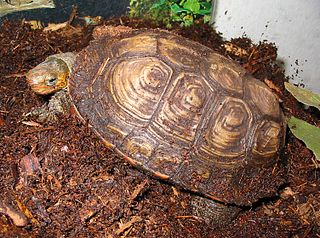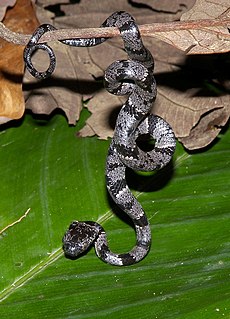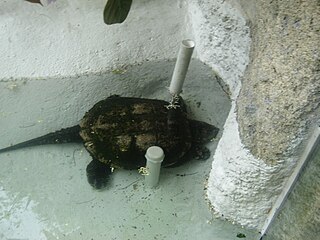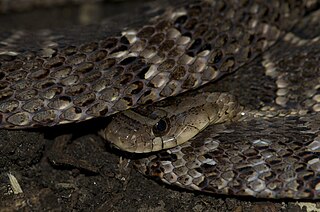 W
WThe Central American banded gecko is a species of moderately-sized gecko in the genus Coleonyx, native to Central America and first identified by Wilhelm Peters in 1863. It is a member of the eyelid geckos.
 W
WThe Central American mud turtle, also known as the narrow-bridged mud turtle, is a species of mud turtle in the Kinosternidae family endemic to Central America. It can be found in the following countries: Costa Rica, Nicaragua and Panama. In terms of reproduction, the female Central American mud Turtle can lay up to 4 eggs at time of reproduction, and multiple times a year.
 W
WThe Central American snapping turtle, also known commonly as the Mexican snapping turtle and the Yucatan snapping turtle, is a species of turtle in the family Chelydridae. The species is endemic to Central America and Mexico.
 W
WThe American crocodile is a species of crocodilian found in the Neotropics. It is the most widespread of the four extant species of crocodiles from the Americas, with populations present from South Florida and the coasts of Mexico to as far south as Peru and Venezuela.
 W
WDipsas is a genus of nonvenomous New World snakes in the subfamily Dipsadinae of the family Colubridae. The genus Sibynomorphus has been moved here.
 W
WDrymarchon is a genus of large nonvenomous colubrid snakes, commonly known as indigo snakes or cribos, found in the Southeastern United States, Central America, and South America. Reaching 3 m (9.8 ft) or more in length, they are among the world's largest colubrid snakes.
 W
WDrymobius margaritiferus, commonly known as the speckled racer, is a species of nonvenomous colubrid snake native to the Americas. The specific name, margaritiferus, means "pearl-bearing" in Latin, referring to the pearl-like spots on the dorsal scales.
 W
WDrymobius melanotropis, commonly known as the black forest racer, is a species of nonvenomous colubrid snake endemic to Central America.
 W
WEpicrates is a genus of non-venomous boas found in South America and Central America. Five species are currently recognized, including the rainbow boa.
 W
WHolcosus festivus, commonly known as the Middle American ameiva, Central American whiptail, or tiger ameiva, is a species of whiptail lizard endemic to Central America and northern South America.
 W
WMesoscincus is a genus of lizards, comprising three species of skinks native to Mexico and Central America. The species were formerly included in the genus Eumeces.
 W
WOxybelis aeneus, commonly known as the Mexican vine snake or brown vine snake, is a species of colubrid snake, which is endemic to the Americas.
 W
WOxyrhopus is a genus of colubrid snakes that belong to the subfamily Dipsadinae. The genus is found in Central America and the northern part of South America, and it includes at least 13 distinct species.
 W
WThe ornate or painted wood turtle is one of nine turtle species of the genus Rhinoclemmys of the family Geoemydidae. There are four recognized subspecies.
 W
WSceloporus variabilis, commonly known as the rosebelly lizard, is a species of lizard, which is endemic to Mexico.
 W
WScincella is a genus of lizards in the skink family, Scincidae, commonly referred to as ground skinks. The exact number of species in the genus is unclear, as taxonomic reclassification is ongoing, and sources vary widely. Scincella species primarily range throughout the temperate regions of the world and are typically small, fossorial lizards, which consume a wide variety of arthropods.
 W
WSibon is a genus of snakes found in northern South America, Central America and Mexico.
 W
WThe banded snail sucker is a species of snake of the family Colubridae.
 W
WThe scorpion mud turtle is a species of mud turtle in the family Kinosternidae. It is found in Mexico, Central and South America. It is a medium to large kinosternid with a domed, oval upper shell 92–270 mm (3.6–10.6 in) long. Males regularly exceed 200 mm. The scorpion mud turtle is a highly aquatic, adaptable kinosternid that will live in almost any body of water. It is primarily omnicarnivorous, a glutton, and feeds on a wide variety of aquatic invertebrates and vertebrates, including carrion. In captivity, poorly fed K. scorpioides can be cannibalistic, biting off the toes and limbs of conspecifics. Females probably lay 1 to 6 hard-shelled eggs. Like many kinosternids, they probably construct a shallow terrestrial nest with little cover.
 W
WThe South American snapping turtle is a species of turtle in the family Chelydridae. This species, which is endemic to Central and northwestern South America, was previously considered a subspecies of Chelydra serpentina. Its restricted range in South America reflects its recent arrival there as part of the Great American Interchange.
 W
WThe white-lipped mud turtle is a species of mud turtle in the family Kinosternidae. The species is endemic to Central America and northwestern South America.
 W
WXenodon rabdocephalus, commonly known as the false fer-de-lance, is a species of venomous rear-fanged snake endemic to Central America and northern South America.